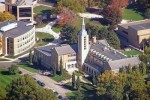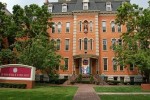New York pharmacy schools are exceptionally competitive higher education institutions. Students seeking admissions from top ranked pharmacy schools in New York will quickly discover a few critical items must be in check. First, you will need to obtain a bachelor degree in an approved area of study. Next, you will need a robust application package that is complete and salient to the admissions team at the school. Last, students must take the Pharmacy College Admissions Test (PCAT) and obtain an acceptable score on this standardized test. Students accepted to a top ranked pharmacy school in New York will have access to exceptional curriculum in a competitive industry. Pharmacy schools are graduate programs that confer doctorate degrees in this field of study as a PharmD or Doctor of Pharmacy. With a degree in hand from a top rated pharmacy school in New York, you can then apply for licensure. The New York board ofpharmacyis the state agency that regulates the industry and issues licenses to qualifying applicants. Pharmacy licensure provides graduates with the opportunity to practice in the private and public sector with a vast array of job responsibilities. Find a list of the best pharmacy schools for you today by using MatchCollege and the myriad educational resources across our digital library.
Detailed List of Pharmacy Schools in New York (8 Schools)
The New York pharmacy schools listed below are accredited by the Accreditation Council for Pharmacy Education, which is an organization that reviews pharmacy education nationwide.
Schools are sorted by size with the largest pharmacy schools first, based on the number of Pharm. D. graduates per year.
St. John's University - New York (SVCMCNY SCHOOL OF NURSING SI) in Staten Island, NY

Visit the website for St. John's University - New York at http://www.stjohns.edu
Program Details
- Pharmacy program accredited since 1940
- About 260 students graduate per year
- Estimated tuition & fees are about $49,000 per year
Albany College of Pharmacy and Health Sciences in Albany, NY

The pharmacy school is located on the Albany College of Pharmacy - Vermont Site Campus in Colchester. Visit the website for Albany College of Pharmacy and Health Sciences at http://www.acphs.edu
Program Details
- Pharmacy program accredited since 1940
- About 220 students graduate per year
- Estimated tuition & fees are about $43,000 per year
Long Island University - C W Post Campus in Syracuse, NY

The pharmacy school is located on the Long Island University - Brooklyn Campus in Brooklyn. Visit the website for Long Island University - C W Post Campus at http://www.liu.edu
Program Details
- Pharmacy program accredited since 1940
- About 190 students graduate per year
- Estimated tuition & fees are about $38,000 per year
University at Buffalo in Vestal, NY

Visit the website for University at Buffalo at http://www.buffalo.edu
Program Details
- Pharmacy program accredited since 1939
- About 130 students graduate per year
- Estimated tuition & fees are about $27,000 per year (Nonresidents: $38,000)
Saint John Fisher College (Fisher) in Utica, NY

Visit the website for Saint John Fisher College at http://www.sjfc.edu
Program Details
- Pharmacy program accredited since 2010
- About 80 students graduate per year
- Estimated tuition & fees are about $43,000 per year
Touro College in Brooklyn, NY

Visit the website for Touro College at http://www.touro.edu
Program Details
- Pharmacy program accredited since 2008
- About 70 students graduate per year
- Estimated tuition & fees are about $42,000 per year
D'Youville College in Plattsburgh, NY

Visit the website for D'Youville College at http://www.dyc.edu
Program Details
- Pharmacy program accredited since 2010
- About 70 students graduate per year
- Estimated tuition & fees are about $37,000 per year
SUNY at Binghamton in Albany, NY
Visit the website for SUNY at Binghamton at http://www.binghamton.edu
Program Details
- Estimated tuition & fees are about $27,000 per year (Nonresidents: $38,000)
Pharmacist's in New york Compared to Median Income Averages
+-12% Above State Median Income
+-2% Above National Median Income
Pharmacist's in New york take home an average 19.00 per hour. Annual earnings for Pharmacist's working in the State of New york average $39,901 which is -12% above the state median income and -2% above the national median income for all occupations. Employment for a Pharmacist makes up just of the working population in New york and is limited due to the specific qualifications required along with the schooling involved in this career path. The increasing demand for qualified Pharmacists coupled with the educational barrier to enter the field is met with a steady supply of eager college graduates anxious to make a long-lasting impact in the lives of others in and around New york.
Pharmacists in New York can expect to make anywhere in the range of $94,000 to $160,000. Below is a list of average salaries for pharmacists working in major cities in New York.
- Rochester: $119,000
- Syracuse: $129,000
- Utica, Rome: $127,000
- Dutchess County, Putnam County: $120,000
- Binghamton: $122,000
Average Income for a Pharmacist in New york
| Employment | Median Hourly Wage | Median Annual Wage | |
|---|---|---|---|
| New york Pharmacist | 73,450 | $19.00 | $39,901 |
| State Average | 9,020,680.00 | $21.50 | $44,720.00 |
| National Average | 155,760,000.00 | $19.33 | $35,977.00 |
Notes: Tuition & fee amounts are for both New York in-state residents and out of state students, unless noted otherwise. The tuition information displayed is an estimate, which we calculated based on historical data and should be solely used for informational purposes only. Please contact the respective pharmacist school for information about the current school year.
Source: IPEDS Survey 2012-2020: Data obtained from the US Dept. of Education's Integrated Postsecondary Education Data System (IPEDS). Data may vary depending on school and academic year.
